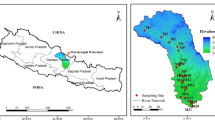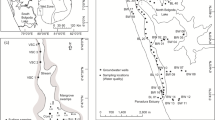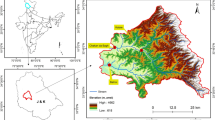Abstract
The Himalayas are one of the largest cryospheric systems outside the Polar Regions, and include more than 12,000 glaciers spread over an area of about 33,000 km2. The Himalayan glaciers and snow packs retreating at an accelerating rate, thereby creating an alarming situation for the huge population that resides in northwestern India and southeastern Pakistan, as they depend on surface water resources in the region and rivers emanating from the Himalayas. This work attempts to quantify the contribution of different sources such as glacial/ice/snow melt and groundwater discharge to the Satluj River using the stable isotopes based hydrograph separation method at Ropar (foot hill) and Yusufpur in plain of Punjab, India. A mass balance model of three-component mixing has been engaged using the values of δ18O and electrical conductivity of the river water, and its discharge fraction, to estimate the time-varying relative proportion of each component from July 2013 to January 2014. The proportion of glacier melt was found to peak up to ~ 64% at Ropar and ~ 15% at Yusufpur during the wet summer months. The fraction of groundwater discharge was found to vary between 10–20% at Ropar and 25–35% at Yusufpur (Punjab plain) over time. The observed trend of d-excess (deuterium excess) values of river water also suggests that the glaciers and snow packs at higher altitudes contain a significant fraction of snow derived from vapor originating in the Mediterranean region, driven by the mid-latitude westerlies known as western disturbances.





Similar content being viewed by others
References
Ageta Y, Higuchi K (1984) Estimation of mass balance components of a summer-accumulation type glacier in the Nepal Himalaya. Geogr Annal Ser A Phys Geogr 66A:249–255
Ahluwalia RS, Rai SP, Jain SK, Kumar B, Dobhal DP (2013) Assessment of snowmelt runoff modeling and isotope analysis: a case study from the western Himalaya, India, Anal Glaciol. https://doi.org/10.3189/2013AoG62A133
Arora M, Rathore DS, Singh RD, Kumar R, Kumar A (2010) Estimation of melt contribution to total streamflow in River Bhagirathi and River Dhauli Ganga at Loharinag Pala and Tapovan Vishnugad Project Sites. J Water Resour Prot 2:636–643. https://doi.org/10.4236/jwarp.2010.27073
BBMB (1988) Snow hydrology studies in India with particular reference to the Satluj and Beas catchments. In: Proceedings of workshop on snow hydrology (Manali, India, 23–26 November, 1988)
Benn DI, Owen LA (1998) The role of Indian summer monsoon and the mid-latitude westerlies in Himalayan glaciation—review and speculative discussion. J Geol Soc Lond 155:353–363
Bhattacharya SK, Gupta SK, Krishnamurthy RV (1985) Oxygen and hydrogen isotopic ratios in groundwaters and river waters from India. Proc Indian Acad Sci Earth Planet Sci 94:283–295
Biggs TW, Chun-Ta L et al (2015) Evaporative fractions and elevation effects on stable isotopes of high elevation lakes and streams in arid western Himalaya. J Hydrol 522:239–249
Buttle JM (1994) Isotope hydrograph separations and rapid delivery of pre-event water from drainage basins. Prog Phys Geogr. https://doi.org/10.1177/030913339401800102
CGWB (2012) Ground water year book. Central Ground Water Board, Ministry of Water Resources. Government of India, Faridabad
Clark ID, Fritz P (1997) Environmental isotopes in hydrogeology. Lewis Publishers, Boca Raton
Craig H (1961a) Standard for reporting concentrations of deuterium and oxygen-18 in natural water. Science 133:1833–1834
Craig H (1961b) Isotopic variations in meteoric waters. Science 133:1702–1703
Dansgaard W (1964) Stable isotopes in precipitation. Tellus 16:436–438
Das PK (2005) The monsoons. National Book Trust, New Delhi
Dincer T, Payne BR, Florkowski T, Martinec J, Tongiorgi E (1970) Snowmelt runoff from measurements of tritium and oxygen-18. Water Resour Res 6:110–124
Dobhal DP, Gergan JT, Thayyen RJ (2004) Recession and morphogeometrical changes of Dokriani glacier (1962–1995) Garhwal Himalaya, India. Curr Sci 86:692–696
Gat JR (2010) Isotope hydrology: a study of water cycle, series on environmental and science, vol 6. Imperial College Press, London, p 190
Gat JR, Carmi I (1970) Evolution of the isotopic composition of atmospheric waters in the Mediterranean Sea area. J Geophys Res 75:3039–3048
Gonfiantini R (1978) Standards for stable isotope measurements in natural compounds. Nature 271:534–536
Gonzales AL, Nonner J, Heijkers J et al (2009) Comparison of different base flow separation methods in a lowland catchment. Hydrol Earth Syst Sci 13:2055–2068. https://doi.org/10.5194/hess-13-2055-2068
Gupta SK, Deshpande RD (2005) Groundwater isotopic investigations in India: what has been learned? Curr Sci 89:825–835
Hendrya MJ (1988) Do isotopes have a place in groundwater studies. Groundwater 26(4):410. https://doi.org/10.1111/j.1745-6584.1988.tb00406.x
Hewitt K (2005) The Karakoram anomaly? Glacier expansion and the “Elevation Effect” Karakoram Himalaya. Mt Res Dev 25:332–340
Hren MT, Bookhage B, Peter MB, Amanda LB, Chamberlain CP (2009) δ18O and δD of stream waters across the Himalaya and Tibetan Plateau: implications for moisture sources and paleoelevation reconstructions. Earth Planet Sci Lett 288:20–32
ICIMOD (International Centre for Integrated Mountain Development) (2001) Inventory of glaciers, glacial lakes and glacial lake outburst floods, monitoring and early warning system in the Hindu Kush-Himalayan region. Nepal UNEP/RCAP/ICIMOD, Kathmandu
Immerzeel WW, Van Beek LPH, Bierkens MFP (2010) Climate change will affect the Asian water towers. Science 328:1382–1385
Immerzeel WW, Pellicciotti F, Bierkens MFP (2013) Rising river flows throughout the twenty-first century in two Himalayan glacierized watersheds. Nat Geosci 6:742–745
Jeelani G, Shah RA, Jacob N, Deshpande RD (2016) Estimation of snow and glacier melt contribution to Liddar stream in a mountainous catchment, western Himalaya: an isotopic approach. Isotopes Environ Health Stud. https://doi.org/10.1080/10256016.2016.1186671
Jeelani G, Deshpande RD, Galkowski M, Rozanski K (2017) Isotopic composition of daily precipitation along southern foothills of the Himalayas: impact of marine and continental sources of atmospheric moisture. Atmos Chem Phys Discuss. https://doi.org/10.5194/acp-2017-774
Jouzel J, Merlivat L (1984) Deuterium and oxygen-18 in precipitation: modeling of the isotopic effects during snow formation. J Geophy Res 89:11749
Karim A, Veizer J (2002) Water balance of the Indus River Basin and moisture source in the Karakoram and western Himalayas: implications from hydrogen and oxygen isotopes in river water. J Geophy Res 107(D18):4362. https://doi.org/10.1029/2000JD000253
Kendall C, McDonnell JJ (1998) Isotope tracers in catchment hydrology. Elsevier, Amsterdam, p 839
Khan AA, Pant NC, Sarkar A, Tandon SK, Thamban M, Mahalinganathan K (2017) The Himalayan cryosphere: a critical assessment and evaluation of glacial melt fraction in the Bhagirathi basin. Geosci Front. https://doi.org/10.1016/j.gsf.2015.12.009
Kulkarni AV, Rathore BP, Mahajan S, Mathur P (2005) Alarming retreat of Parbati glacier, Beas basin, Himachal Pradesh. Curr Sci 88:1844–1850
Kulkarni AV, Bahuguna IM, Rathore BP, Singh SK, Randhawa SS, Sood RK, Dhar S (2007) Glacial retreat in Himalaya using Indian Remote Sensing satellite data. Curr Sci 92:69–74
Kumar A, Rao DK, Bhattacharya SK (2007a) Oxygen and hydrogen isotopic composition of waters from a few selected Himalayan rivers, India. In: Proceedings of 12th ISMAS symposium cum workshop on mass spectrometry, March 25–30. India Indian Society for Mass Spectrometry (ISMAS), Goa, India, RSP 6
Kumar V, Singh P, Singh V (2007b) Snow and glacier melt contribution in the Beas River at Pandoh Dam, Himachal Pradesh, India. Hydrol Sci J 52:376–388
Kumar K, Dumka RK, Miral MS, Satyal GS, Pant M (2008) Estimation of retreat rate of Gangotri glacier using rapid static and kinematic GPS survey. Curr Sci 94:258–262
Kumar B, Rai SP, Saravana K, Verma U, Garg SK, Vijayakumar P, Jaiswal SV, Purendr R, Kumar BK, Pande NG (2010) Isotopic characteristics of Indian precipitation. Water Resour Res. https://doi.org/10.1029/2009WR008532
Lambs L (2000) Correlation of conductivity and stable isotope 18O for the assessment of water origin in river system. Chem Geol 164:161–170
Lide T, Tandong Y, White JWC, Wusheng Y, Ninglian W (2005) Westerly moisture transport to the middle of Himalayas revealed from the high deuterium excess. Chin Sci Bull 50:1026–1030. https://doi.org/10.1007/s11434-11005-11026-11438
Lide T, Tandong Y et al (2007) Stable isotopic variations in west China: a consideration of moisture sources. J Geophy Res 112:D10112. https://doi.org/10.1029/2006JD007718
Margat J, Van der Gun J (2013) Groundwater around the world: a geographic synopsis. CRC Press, Boca Raton
Maurya AS, Shah M, Deshpande RD, Gupta SK (2009) Protocol for δ18O and δD analyses of water sample using Delta V plus IRMS in CF Mode with Gas Bench II for IWIN National Programme at PRL, Ahmedabad. In: Aggarwal SK, Jaison PG, Sarkar A, Kumar P (eds) Proceedings of the 11th ISMAS Triennial Conference Indian Society for Mass Spectrometry, Mumbai, Hyderabad, pp 314–317
Maurya AS, Shah M, Deshpande RD, Bhardwaj RM, Prasad A, Gupta SK (2011) Hydrograph separation and precipitation source identification using stable water isotopes and conductivity: River Ganga at Himalayan foothills. Hydrol Proc 25:1521–1530
Merlivat L, Jouzel J (1979) Global climate interpretation of the deuterium–oxygen18 relationship foe precipitation. J Geophys Res 84:5029–5033
Mir RA, Jain SK, Saraf AK, Goswami A (2015) Decline in snowfall in response to temperature in Satluj basin, western Himalaya. J Earth Syst Sci 124(2):365–382
Naithani AK, Nainwal HC, Sati KK, Prasad C (2001) Geomorphological evidences of retreat of the Gangotri glacier and its characteristics. Curr Sci 80:87–94
Oldham RD (1917) Structure of the Himalaya and Indo-Gangetic plains. Mem Geol Surv India 156:78–94
Pande K, Padia JT, Ramesh R, Sharma KK (2000) Stable isotope systematics of surface water bodies in the Himalayan and Trans-Himalayan (Kashmir) region. Proc Indian Acad Sci Earth Planet Sci 109:109–115
Rai SP, Kumar B, Singh P (2009) Estimation of contribution of southwest monsoon rain to Bhagirathi River near Gaumukh, western Himalayas, India, using oxygen-18 isotope. Curr Sci 97:240–245
Rai SP, Thayyen RJ, Purushothaman P, Kumar B (2016) Isotopic characteristics of cryospheric waters in parts of Western Himalayas, India. Environ Earth Sci. https://doi.org/10.1007/s12665-016-5417-8
Rao KL (1975) India’s water wealth. Orient Longman, New Delhi
Ren W, Yao T, Xie S (2016) Water stable isotopes in the Yarlungzangbo headwater region and its vicinity of the southwestern Tibetan Plateau. Tellus B Chem Phys Meteorol 68(1):30397. https://doi.org/10.3402/tellusb.v68.30397
Rodriguez JP, McIntyre N, Díaz-Granados M, Quijano JP, Maksimović C (2013) Monitoring and modeling to support wastewater system management in developing mega-cities. Sci Total Environ 445–446:79–93. https://doi.org/10.1016/j.scitotenv.2012.12.022
Rozanski K, Araguas-Araguas L, Gonfiantini R (1993) Isotopic patterns in modern global precipitation. In: Swart PK, Lohmann KC, McKenzie J, Savin S (eds) Climate change in continental isotopic records. American Geophysical Union, Washington, DC, pp 1–36
Shah T (2007) The groundwater economy of South Asia: an assessment of size, significance and socio-ecological impacts. In: Giordano M, Villholth KG (eds) The agricultural groundwater revolution: opportunities and threats to development, pp 7–36
Singh BP (2017) Original isotopic composition of water in precipitation by different methods. Appl Wat Sci 7(6):3385–3390
Singh P, Jain SK (2002) Snow and glacier melt in the Satluj River at Bhakra Dam in the western Himalayan region. Hydrol Sci J 47:93–106
Singh P, Jain SK, Kumar N (1997) Estimation of snow and glacier contribution to the Chenab River, Western Himalaya. Mt Res Dev 17:49–55
Sophocleous M (2002) Interactions between groundwater and surface water: the state of the science. Hydrogeol J 10(1):52–67
Taylor S, Feng X, Williams M, McNamara J (2002) How isotopic fractionation of snowmelt affects hydrograph separation. Hydrol Process 16:3683–3690
Veen IV, Baethold F, Hoffmann B, Sachse D, Strecker MR (2014) Streamwater δD and δ18O values in the Sutlej valley, NW India. Goldschmidt-2014 Abstracts-2552
Wulf H, Bookhagen B, Scherler D (2016) Differentiating between rain, snow, and glacier contributions to river discharge in the western Himalaya using remote-sensing data and distributed hydrological modeling. Adv Water Resour 88:152–169
Acknowledgements
The authors are thankful to International Atomic Energy Agency (IAEA), Vienna for providing partial funding for the study in the form of Project (CRP17391India) to SPR. The authors acknowledge the Director, National Institute of Hydrology, Roorkee and Indian Institute of Technology Roorkee for helping in carrying out the study. Authors are also thankful to IWIN National Programme (PRL, Ahmedabad) for sharing isotope data of precipitation from Kangra Valley. Ms Neha Rarh and Mr A K Ojha are thankfully acknowledged for drafting the figures; and authors are also thankful to anonymous reviewers for their critical comments and suggestions to improve the quality of manuscript.
Author information
Authors and Affiliations
Corresponding author
Rights and permissions
About this article
Cite this article
Maurya, A.S., Rai, S.P., Joshi, N. et al. Snowmelt runoff and groundwater discharge in Himalayan rivers: a case study of the Satluj River, NW India. Environ Earth Sci 77, 694 (2018). https://doi.org/10.1007/s12665-018-7849-9
Received:
Accepted:
Published:
DOI: https://doi.org/10.1007/s12665-018-7849-9




